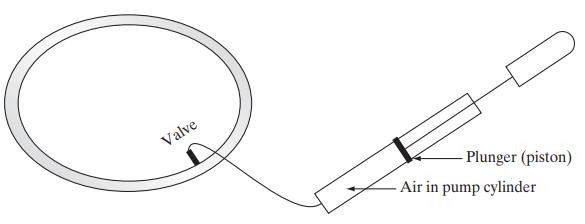A bicycle pump can be treated as a piston-and-cylinder system that is connected to the tire at
Question:
A bicycle pump can be treated as a piston-and-cylinder system that is connected to the tire at the “closed” end of the cylinder. The connection is through a valve that is initially closed, while the cylinder is filled with air at atmospheric pressure, following which the pumping in a cycle occurs as the plunger (piston) is pushed further into the cylinder. When the air pressure in the cylinder increases until it reaches the same pressure as that in the tire, the valve opens and further movement of the piston forces air from the pump into the tire. The whole process occurs quickly enough that there is no significant heat flow to or from the surroundings to the pump or tire during the pumping process. Thus, a single pumping cycle can be considered a three-step process. First, air is drawn into the pump cylinder at constant pressure. Second, as the pumping begins, the valve is closed so that the pressure increases without a flow of air from the pump. Third, the valve opens and the pumping action forces air into the tire. Here we are interested in calculations only for the second step if the tire pressure is initially 60 psig (5.15 bar absolute). For reference, the cylinder of a bicycle hand pump is about 50 cm long and about 3 cm in diameter.

a. If the ambient temperature is 25°C and air is treated as an ideal gas with C∗P = 29.3 J/(mol K), how far down will the piston have moved before the valve opens? What is the temperature of the gas?
b. Repeat the calculation of part (a) if the PengRobinson equation is used to describe air, assuming that the critical constants and acentric factor of air are the same as for nitrogen.
Step by Step Answer:

Chemical Biochemical And Engineering Thermodynamics
ISBN: 9780470504796
5th Edition
Authors: Stanley I. Sandler





